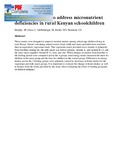Designing snacks to address micronutrient deficiencies in rural Kenyan schoolchildren

View/
Date
2007Author
Murphy, SP
Gewa, C
Grillenberger, M
Bwibo, NO
Neumann, CG
Type
ArticleLanguage
enMetadata
Show full item recordAbstract
Three snacks were designed to improve nutrient intakes among school-age children living in rural Kenya. Snacks containing animal-source foods (milk and meat) provided more nutrients than an equicaloric vegetarian snack. The vegetarian snack provided extra vitamin A (primarily from fortified cooking fat; the milk snack was rich in calcium, vitamin A, and vitamin B-12; and the meat snack supplied vitamin B-12, iron, and zinc. When changes in intakes from baseline to the feeding period were compared across the 4 groups, total energy intake increased the most for children in the meat group and the least for children in the control group. Differences in energy intakes across the 3 feeding groups were primarily caused by decreases in home intake for the vegetarian and milk snack groups. It is important to evaluate the change in home intakes as well as intakes from the foods provided by the study when evaluating the effect of feeding programs on nutrient adequacy
URI
http://www.ncbi.nlm.nih.gov/pubmed/17374685http://erepository.uonbi.ac.ke:8080/xmlui/handle/123456789/15969
Citation
J Nutr. 2007 Apr;137(4):1093-6Publisher
Department of Paediatrics and Child Health, University of Nairobi University of California, Los Angeles, CA 90095; Wageningen University, Wageningen, The Netherlands
Collections
- Faculty of Health Sciences (FHS) [10378]
